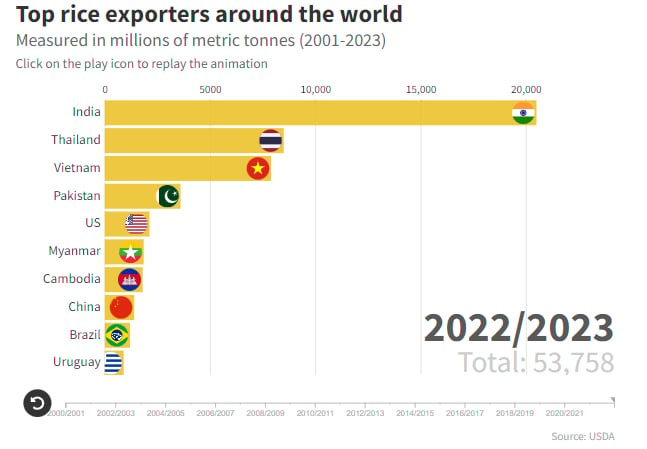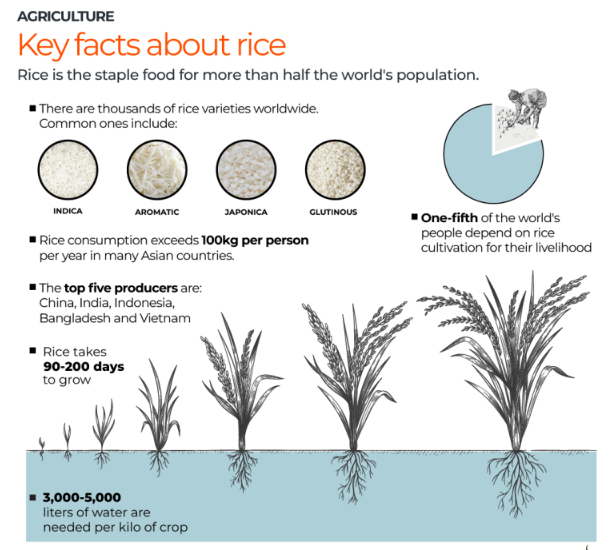November 21, 2025 | 19:38 GMT +7
November 21, 2025 | 19:38 GMT +7
Hotline: 0913.378.918
November 21, 2025 | 19:38 GMT +7
Hotline: 0913.378.918

Global rice prices are at their highest levels in 15 years, according to the United Nations Food and Agriculture Organization (FAO).
The surge follows India’s announcement on July 20 that it would cease the export of non-basmati white rice with immediate effect. The decision came just days after Russia halted participation in the Black Sea Grain Initiative, causing global food commodity prices to rise.
Traders have said a shortage of rice will have a knock-on effect on wheat, soya beans, corn and maize, which are used as rice substitutes.
In this infographic series, Al Jazeera visualises India’s rise to becoming the world’s largest exporter of rice and the nations that rely most on Indian rice exports.
The practice of cultivating rice in paddies is believed to have originated about 8,000 BC along the Yangtze River in central China and then spread to India and other parts of Asia.
Rice is the third most-produced grain in the world after corn and wheat and typically takes 90 to 200 days to grow depending on the variety and environmental conditions.
There are thousands of rice varieties worldwide, each differing in terms of grain size, shape, colour, texture and cooking characteristics.
Rice is one of the most water-intensive crops to cultivate, typically requiring 3,000 to 5,000 litres of water per kilogramme of crop – about three times more water than wheat requires to grow.
India’s export ban was imposed to control domestic prices and as a precautionary measure against the warming El Nino weather pattern, which can cause droughts leading to lower yields or even crop failures.

Cheap domestic rice has made India the world’s largest rice exporter, accounting for nearly 40 percent of total rice exports, which is projected to reach 54 million tonnes over the 2022-2023 crop year.
India will export an estimated 20.5 million tonnes of milled rice this year, almost 2.5 times that of the second largest exporter, Thailand with 8.5 million tonnes. Thailand is followed by Vietnam (7.9 million tonnes), Pakistan (3.6 million tonnes) and the United States (2.1 million tonnes).
India has dominated rice exports over the past decade due in part to low local prices and high domestic stocks, which allows the country to offer rice at discounts.
The animation below shows the world’s top rice exporters from 2001 to 2023:
From January to July, India exported about 12.9 million tonnes of rice worth nearly $7bn to at least 150 countries, according to India’s Directorate General of Commercial Intelligence and Statistics.
Three-quarters (77 percent) of India’s rice exports have been non-basmati parboiled rice while the remaining quarter (23 percent) has been basmati rice.
At 1.17 million tonnes, the West African country Benin has bought the most Indian non-basmati rice this year followed by Senegal (872,080 tonnes) and Kenya (685,302 tonnes).
Eight of the top 10 destinations for India’s rice are African nations that predominantly import broken rice, the cheapest and most filling variety.
India’s largest buyers of basmati rice this year were Saudi Arabia (639,150 tonnes), Iran (545,751 tonnes) and Iraq (383,687 tonnes).
The graphic below shows the top buyers of India’s non-basmati and basmati rice.
After India’s ban, the US Department of Agriculture (USDA) has lowered global rice trade forecasts for 2023 and 2024 with the organisation saying trade in the 2024 calendar year for milled rice is projected to be 52.9 million tonnes, down by 3.44 million tonnes from previous forecasts.
The ban has had a knock-on effect on the price of other rice varieties, and the high rice prices are unlikely to abate in the short term. The FAO has suggested that any likely recovery in rice trade by next year would require India’s export restrictions to be lifted.
(AL JAZEERA)

(VAN) In a new study published in Trends in Biotechnology, researchers used a gene-editing technology called CRISPR to increase a fungus's production efficiency and cut its production-related environmental impact by as much as 61%- all without adding any foreign DNA.

(VAN) A top official in Beijing’s Cop delegation says China is committed to clean energy – but US’s absence is a problem.

(VAN) The Bangsamoro region’s inflation rate rose slightly to –1.3 percent in October 2025 from –1.5 percent in September, the Philippine Statistics Authority (PSA-BARMM) reported.

(VAN) FAO-led report says protecting and restoring forests is crucial to boosting climate-resilient agriculture, rural livelihoods and global food and water security.

(VAN) Flagship partnership secures additional GBP 16.9 million to strengthen forest monitoring, transparency and country support to 2030.

(VAN) After a turbulent year for international development, the aid and assistance landscape has shifted, with donors rethinking how, where and why they support sustainable development.

(VAN) A new tool for measuring the economic value of farm animal welfare improvements has been developed, potentially transforming how consumers, retailers and the government evaluate animal welfare policies.